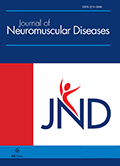Authors: Samões, Raquel | Oliveira, Jorge | Taipa, Ricardo | Coelho, Teresa | Cardoso, Márcio | Gonçalves, Ana | Santos, Rosário | Melo Pires, Manuel | Santos, Manuela
Article Type:
Research Article
Abstract:
Background: Pathogenic variants in ryanodine receptor type 1 (RYR1 ) gene are an important cause of congenital myopathy. The clinical, histopathologic and genetic spectrum is wide. Objective: Review a group of the patients diagnosed with ryanodinopathy in a tertiary centre from North Portugal, as an attempt to define some phenotypical patterns that may help guiding future diagnosis. Methods: Patients were identified from the database of the reference centre for Neuromuscular Disorders in North Portugal. Their data (clinical, histological and genetic) was retrospectively accessed. Results: Seventeen RYR1-related patients (including 4 familial cases) were
…identified. They were divided in groups according to three distinctive clinical characteristics: extraocular muscle (EOM) weakness (N = 6), disproportionate axial muscle weakness (N = 2) and joint laxity (N = 5). The fourth phenotype includes patients with mild tetraparesis and no distinctive clinical features (N = 4). Four different histopathological patterns were found: centronuclear (N = 5), central core (N = 4), type 1 fibres predominance (N = 4) and congenital fibre type disproportion (N = 1) myopathies. Each index case, except two patients, had a different RYR1 variant. Four new genetic variants were identified. All centronuclear myopathies were associated with autosomal recessive inheritance and EOM weakness. All central core myopathies were caused by pathogenic variants in hotspot 3 with autosomal dominant inheritance. Three genetic variants were reported to be associated to malignant hyperthermia susceptibility. Conclusions: Distinctive clinical features were recognized as diagnostically relevant: extraocular muscle weakness (and centronuclear pattern on muscle biopsy), severe axial weakness disproportionate to the ambulatory state and mild tetraparesis associated with (proximal) joint laxity. There was a striking genetic heterogeneity, including four new RYR1 variants.
Show more
Keywords: Central core, centronuclear, congenital myopathies, joint laxity, malignant hyperthermia, myopathy, ryanodine receptor 1, RYR1
DOI: 10.3233/JND-160199
Citation: Journal of Neuromuscular Diseases,
vol. 4, no. 1, pp. 67-76, 2017
Price: EUR 27.50





